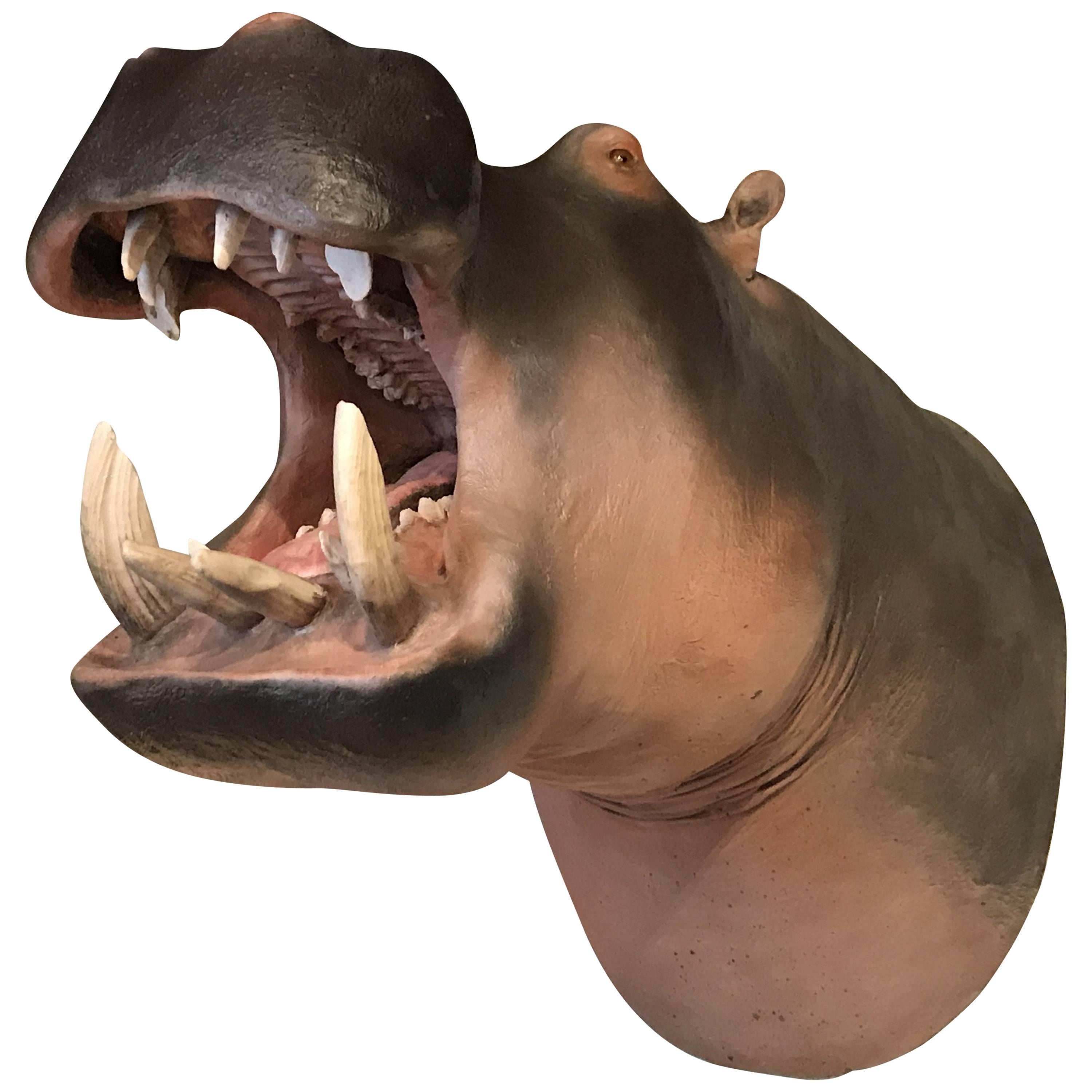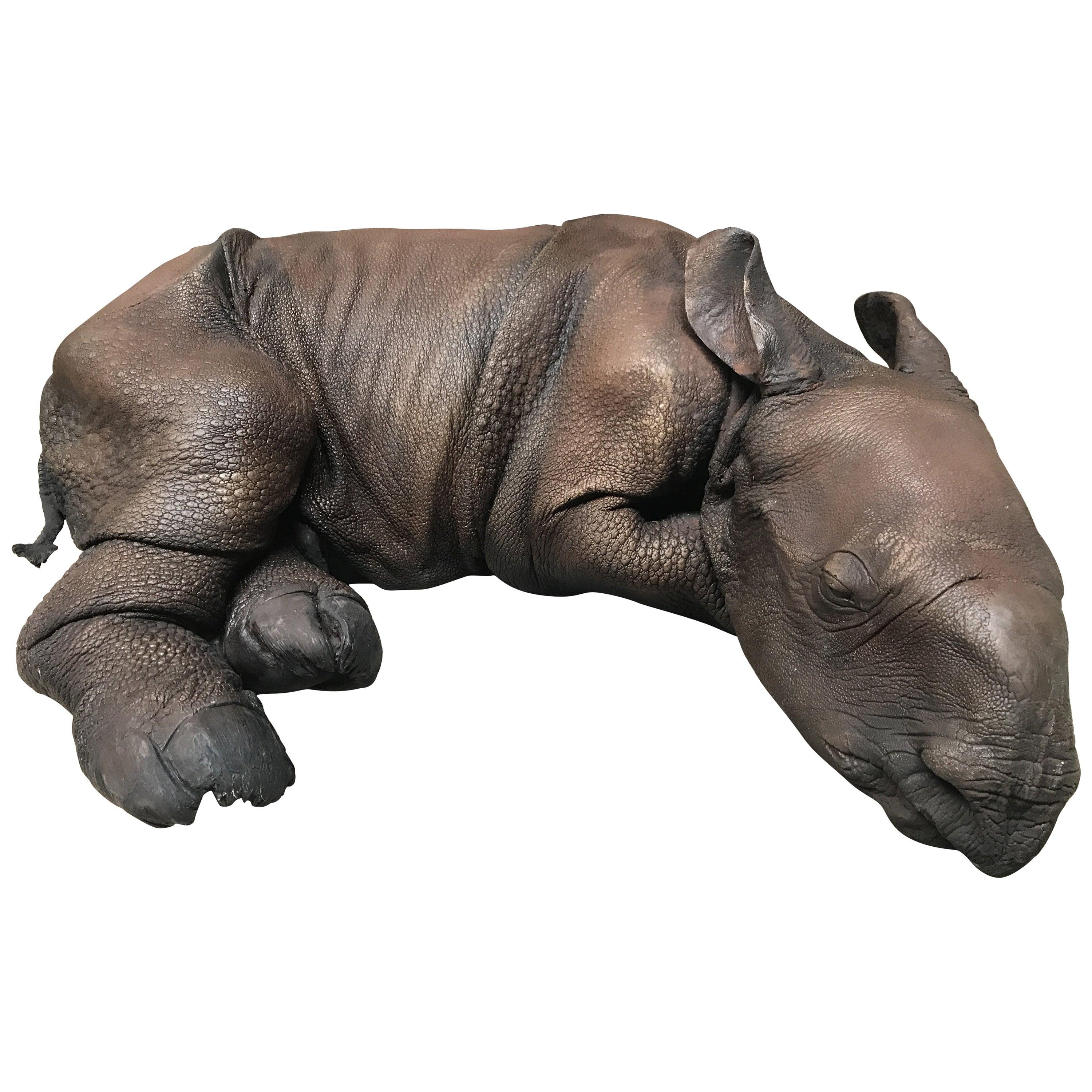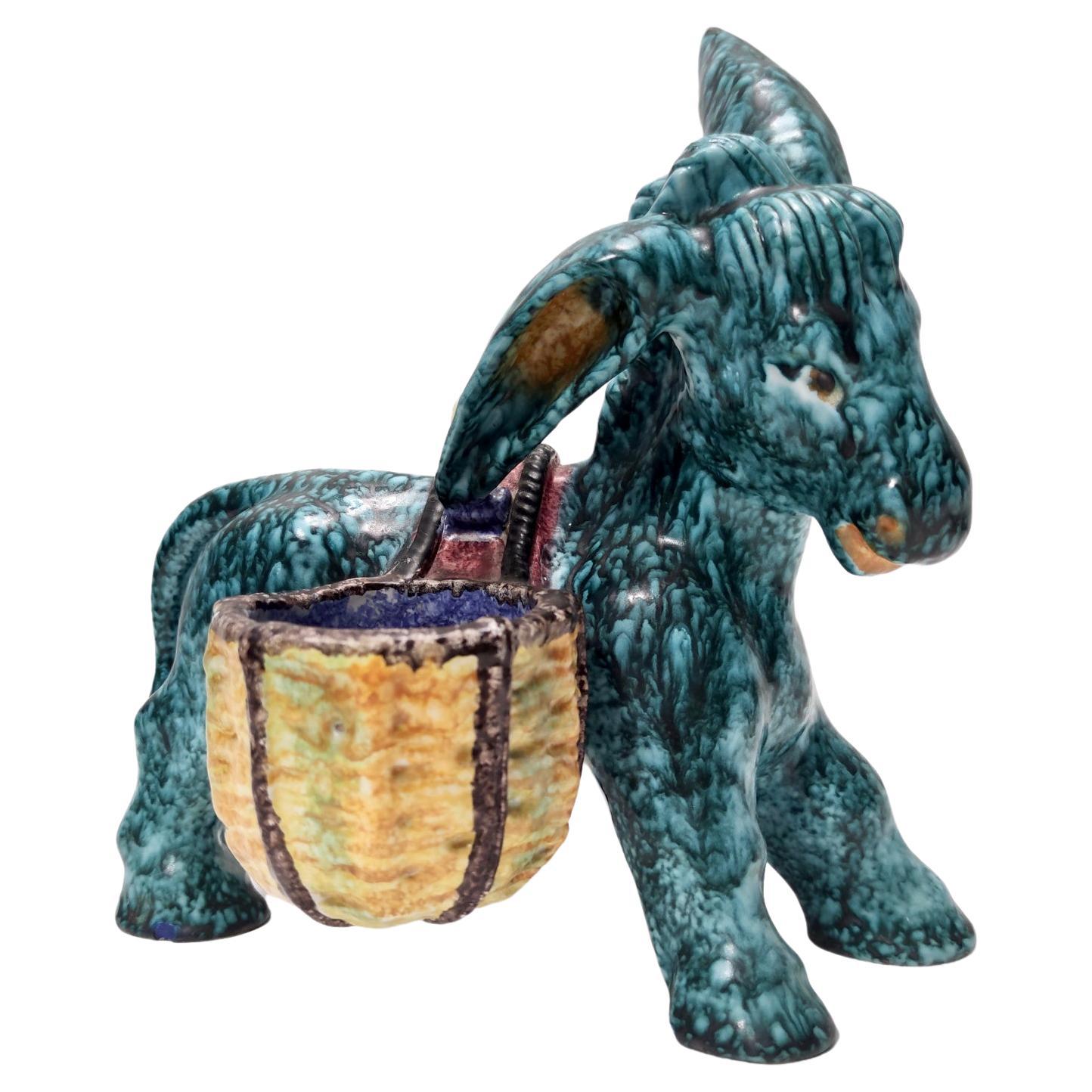Items Similar to Rare replica of Benvenuto Cellini’s Renaissance Salt Cellar for Francis I
Want more images or videos?
Request additional images or videos from the seller
1 of 6
Rare replica of Benvenuto Cellini’s Renaissance Salt Cellar for Francis I
About the Item
Rare replica of Benvenuto Cellini’s Renaissance Salt Cellar for Francis I
Produced by Morpier Argenteria; after Benvenuto Cellini
Florence, Italy; 1970’s
Gilt silver, enamel, resin and wood
Approximate size: 10.6 (h) x 13.75 (w) x 8.5 (d) in.
A rare reproduction of Benvenuto Cellini’s ‘La Saliera d’Oro’ or ‘golden salt cellar’ produced originally in a limited edition of 499 examples and executed by the museum-quality production firm, Morpier Argenteria, in Florence during the 1970’s (the present example is no. 67). To the present author’s knowledge, authorized reproductions of Cellini’s salt cellar are infrequent. The Argenterie di Milano produced a limited quantity of fine replicas during the 1960’s (see an example offered on 1st Dibs for the price of $154,000).
Our example was recently used in a major film production coming to theatres in late 2024. Details available upon request.
Cellini’s salt cellar is today considered the singular masterpiece of goldsmiths work from the Renaissance. The original was commissioned by King Francis I of France in 1543 and is today preserved in the Kunsthistorisches Museum in Vienna. The original was stolen in 2003, resulting in an aggressive hunt for its recovery. It was subsequently returned to the museum in 2006 and is today insured for approximately 70 million dollars, attesting to its cultural and historical significance as the most precious work coming down to us from the European Renaissance.
During the Renaissance, fine tableware was commissioned by the wealthy and executed by the talented silver and goldsmiths of the period whom produced silverware, ewers and other accoutrements for the serving and setting of food. The present salt cellar would have held expensive salts, stored in the urn and temple featured on this elaborate sculpture. The cellar is flanked by figural expressions of the Sea and Earth and the theme is accentuated by small reliefs circumnavigating the base which are grounded by fine enamels. The present example is cast in resin and plated with gilt silver, hand-applied colored enamels and is set on a wood base. The reproduction is quite faithful to the original and exemplifies the incredibly mastery of Cellini’s inventiveness and talents.
Good general condition. Minor craquelure to the gilding with some natural tarnishing present. Very minor losses
to some of the enamel work. The fork held by Neptune is slightly bent. Half of the felt lining along the base of the sculpture is lost. Otherwise, the condition is commensurate with age.
- Dimensions:Height: 10.6 in (26.93 cm)Width: 13.75 in (34.93 cm)Depth: 8.5 in (21.59 cm)
- Materials and Techniques:
- Period:
- Date of Manufacture:unknown
- Condition:Wear consistent with age and use. Minor losses.
- Seller Location:Leesburg, VA
- Reference Number:1stDibs: LU8166239681382
About the Seller
5.0
Vetted Seller
These experienced sellers undergo a comprehensive evaluation by our team of in-house experts.
Established in 2013
1stDibs seller since 2023
21 sales on 1stDibs
Typical response time: 1 hour
- ShippingRetrieving quote...Ships From: Leesburg, VA
- Return PolicyThis item cannot be returned.
More From This SellerView All
- Rare Vintage Monumental Porcelain Horse Drawn Victorian Carriage centerpieceBy CapodimonteLocated in Leesburg, VARare Vintage Monumental Porcelain Horse Drawn Victorian Carriage centerpiece group Capodimonte Porcelain, after a model by Giorgio Galletti Naples, Italy; second half of the 20th century Porcelain Approximate size: 37 (w) x 15 (h) x 10 (d) in. This beautiful and elaborately detailed porcelain group features an ornately modeled carriage drawn by four horses. The coach features a driver seated on his perch wearing a tricorn hat and a lovely lady is seated in the coach box wearing a light blue dress with intricate gesticulating openwork porcelain lace...Category
Late 20th Century Italian Late Victorian Figurative Sculptures
MaterialsPorcelain
- Rare and important painted bronze Crucifix after a model by MichelangeloBy Michelangelo BuonarrotiLocated in Leesburg, VAA rare and very fine bronze corpus of Christ after a model by Michelangelo, cast ca. 1597-1600 by Juan Bautista Franconio and painted in 1600 by Francisco Pacheco in Seville, Spain. The present corpus reproduces a model attributed to Michelangelo. The best known example, lesser in quality, is one on display at the Metropolitan Museum of Art (MET). The association of this corpus with Michelangelo was first brought to light by Manuel Gomez-Moreno (1930-33) who studied the wider circulated casts identified throughout Spain. The attribution to Michelangelo was subsequently followed by John Goldsmith-Phillips (1937) of the MET and again by Michelangelo expert, Charles de Tolnay (1960). While Michelangelo is best known for his monumental works, there are four documented crucifixes he made. The best known example is the large-scale wooden crucifix for the Church of Santa Maria del Santo Spirito in Florence, made in 1492 as a gift for the Prior, Giovanni di Lap Bicchiellini, for allowing him to study the anatomy of corpses at the hospital there. In 1562, Michelangelo wrote two letters to his nephew, Lionardo, indicating his intention to carve a wooden crucifix for him. In 1563 a letter between Lionardo and the Italian sculptor Tiberio Calcagni, mentions this same crucifix (a sketch of a corpus on the verso of a sheet depicting Michelangelo’s designs for St. Peter’s Basillica [Palais des Beaux-Arts in Lille] may reproduce this). That Michelangelo was working on small corpora in the last years of his life is further evidenced by the small (26.5 cm) unfinished wooden crucifix located at the Casa Buonarroti, considered his last known sculptural undertaking. Michelangelo’s contemporary biographer, Giorgio Vasari additionally cites that Michelangelo, in his later years, made a small crucifix for his friend, Menighella, as a gift. Surviving sketches also indicate Michelangelo’s study of this subject throughout his career, most notably during the end of his life but also during the 1530s-40s as he deepened his spiritual roots. The occasional cameo of crucified Christ’s throughout his sketched oeuvre have made it challenging for scholars to link such sketches to any documented commissions of importance. All the while, in consideration that such objects were made as gifts, it is unlikely they should be linked with commissions. Nonetheless, a number of theories concerning Michelangelo’s sketches of Christ crucified have been proposed and some may regard the origin of the present sculpture. It has been suggested that the corpus could have its impetus with Michelangelo’s work on the Medici Chapel, whose exclusive design was given to the master. It is sensible smaller details, like an altar cross, could have fallen under his responsibility (see for example British Museum, Inv. 1859,0625.552). Others have noted the possibility of an unrealized large marble Crucifixion group which never came to fruition but whose marble blocks had been measured according to a sheet at the Casa Buonarroti. A unique suggestion is that Michelangelo could have made the crucifix for Vittoria Colonna, of whom he was exceedingly fond and with whom he exchanged gifts along with mutual spiritual proclivities. In particular, Vittoria had an interest in the life of St. Bridget, whose vision of Christ closely resembles our sculpture, most notably with Christ’s proper-left leg and foot crossed over his right, an iconography that is incredibly scarce for crucifixes. The suggestion could add sense to Benedetto Varchi’s comment that Michelangelo made a sculpted “nude Christ…he gave to the most divine Marchesa of Pescara (Vittoria Colonna).” Of that same period, two sketches can be visually linked to our sculpture. Tolnay relates it to a sketch of a Crucified Christ at the Teylers Museum (Inv. A034) of which Paul Joannides comments on its quality as suggestive of preparations for a sculptural work. Joannides also calls attention to a related drawing attributed to Raffaello da Montelupo copying what is believed to be a lost sketch by Michelangelo. Its relationship with our sculpture is apparent. Montelupo, a pupil of Michelangelo’s, returned to Rome to serve him in 1541, assisting with the continued work on the tomb of Pope Julius II, suggesting again an origin for the corpus ca. 1540. The earliest firm date that can be given to the present corpus is 1574 where it appears as a rather crudely conceived Crucifixion panel, flanked by two mourners in low-relief and integrally cast for use as the bronze tabernacle door to a ciborium now located at the Church of San Lorenzo in Padula. Etched in wax residue on the back of the door is the date, 27 January 1574, indicating the corpus would have at least been available as a model by late 1573. The Padula tabernacle was completed by Michelangelo’s assistant, Jacopo del Duca and likely has its origins with Michelangelo’s uncompleted tabernacle for the Basilica of St. Mary of the Angels in Rome. The impetus for the Padula tabernacle’s Crucifixion panel begins with a series of late Crucifixion sketches by Michelangelo, depicting a scene of Christ crucified and flanked by two mourners (see British Museum Inv. 1895.0915.510; Ashmolean Museum Inv. 1846.89, KP II 343 recto; Windsor Castle RCIN 912761 recto; and Louvre Inv. 700). A faintly traced block possibly intended for sculpting the sketch of the crucified Christ on its recto was discovered by Tolnay on a version of the composition at Windsor Castle. The Windsor sketch and those related to it appear to have served as preparatory designs for what was probably intended to become the Basilica of St. Mary’s tabernacle door. Vasari documents that the project was to be designed by Michelangelo and cast by his assistant, Jacopo del Duca. Michelangelo died before the commission was complete, though on 15 March 1565, Jacopo writes to Michelangelo’s nephew stating, “I have started making the bronze tabernacle, depending on the model of his that was in Rome, already almost half complete.” Various circumstances interrupted the completion of the tabernacle, though its concept is later revitalized by Jacopo during preparations to sell a tabernacle, after Michelangelo’s designs, to Spain for Madrid’s El Escorial almost a decade later. The El Escorial tabernacle likewise encountered problems and was aborted but Jacopo successfully sold it shortly thereafter to the Carthusians of Padula. An etched date, 30 May 1572, along the base of the Padula tabernacle indicates its framework was already cast by then. A 1573 summary of the tabernacle also describes the original format for the door and relief panels, intended to be square in dimension. However, a last minute decision to heighten them was abruptly made during Jacopo’s negotiations to sell the tabernacle to King Phillip II of Spain. Shortly thereafter the commission was aborted. Philippe Malgouyres notes that the Padula tabernacle’s final state is a mixed product of the original design intended for Spain’s El Escorial, recycling various parts that had already been cast and adding new quickly finished elements for its sale to Padula, explaining its unusually discordant quality, particularly as concerns the crudeness of the door and relief panels which were clearly made later (by January 1574). Apart from his own admission in letters to Spain, it is apparent, however, that Jacopo relied upon his deceased master’s designs while hastily realizing the Padula panels. If Michelangelo had already earlier conceived a crucifix model, and Jacopo had access to that model, its logical he could have hastily employed it for incorporation on the door panel to the tabernacle. It is worth noting some modifications he made to the model, extending Christ’s arms further up in order to fit them into the scale of the panel and further lowering his chin to his chest in order to instill physiognomic congruence. A crude panel of the Deposition also follows after Michelangelo’s late sketches and is likewise known by examples thought to be modifications by Jacopo based upon Michelangelo’s initial sculptural conception (see Malgouyres: La Deposition du Christ de Jacopo del Duca, chef-d’oeuvre posthume de Michel-Ange). Jacopo’s appropriation of an original model by Michelangelo for more than one relief on the Padula tabernacle adds further indication that the crucifix was not an object unique to Jacopo’s hand, as few scholars have posited, but rather belongs to Michelangelo’s original...Category
Antique 16th Century Renaissance Figurative Sculptures
MaterialsBronze
- Pair of Natural Striped Chambered Nautilus Half ShellsLocated in Leesburg, VAPair of Natural Striped Chambered Nautilus Half Shells Nautilus Pompulus Philippines; harvested in the 20th century Approximate size: 6.75 (w) x 5.5 (h) x 2.75 (d) in. Nautilus sh...Category
20th Century Philippine Organic Modern Natural Specimens
MaterialsShell
- 19th Century Articulated Wooden Figure of the Virgin MaryLocated in Leesburg, VA19th century articulated wooden figure of the Virgin Mary Anonymous Spain; 19th century Polychrome wood, inset glass eyes Approximate size: 37 x 11 x 7 cm An antique ‘Virgin...Category
Antique 19th Century Primitive Figurative Sculptures
MaterialsGlass, Wood, Paint
- An antique 18th century Walnut European Santos - Saint figure on a plinthLocated in Leesburg, VAAn antique 18th century Walnut Figural Statue of Saint Peter on a plinth Anonymous Northern Europe, probably Belgium; first-half of the 18th century Walnut Approximate size: 17 (h) x 4.25 (w) x 4.25 (d) in. The present sculpture, perfectly suited for a curiosity cabinet or English-European country styled home, was likely realized for a church side chapel or choir stall niche. The serious look of the saint’s face...Category
Antique Early 18th Century Belgian Baroque Figurative Sculptures
MaterialsWalnut
- Original Hand-Carved South Asian Antique Architectural Bracket FragmentLocated in Leesburg, VAOriginal Hand-Carved South Asian Antique Architectural Bracket Fragment for display Anonymous Probably India; early-to-mid 20th century Wood Approximate size: 4.2 x 3.8 x 12 in. A...Category
Early 20th Century Indian Anglo-Indian Mounted Objects
MaterialsWood, Paint
You May Also Like
- 20th Century Italian Silver 800 and Ebony "Benvenuto Cellini Salt Cellar"ReplicaBy Argenterie di MilanoLocated in VALENZA, ITFantastic reproduction of the famous saltcellar of Benvenuto Cellini, symbol of the world goldsmith's art. The master goldsmith made only very few copies of this wonderful object that makes it a unique piece in the world. 6.641 grams of solid silver. Some information on the original piece by Benvenuto Cellini: The Cellini Salt...Category
Vintage 1980s Italian Renaissance Sterling Silver
MaterialsSilver
- Lifelike Replica of a HippopotamusLocated in Eindhoven, NLLifelike replica of a hippopotamus. The hippo head has all the details.Category
21st Century and Contemporary Belgian Animal Sculptures
MaterialsFiberglass, Polyester
- Lifelike Replica of a Rhino CalfLocated in Eindhoven, NLLifelike replica of a rhino calf. The calf has all the details and can not be distinguished from real.Category
21st Century and Contemporary European Taxidermy
MaterialsPolyester
- Lifelike Replica of a Rhino CalfLocated in Eindhoven, NLLifelike replica of a rhino calf. The calf has all the details and cannot be distinguished from real.Category
21st Century and Contemporary European Taxidermy
MaterialsPolyester
- Lifelike Replica of a Hippo CalfLocated in Eindhoven, NLLifelike replica of a hippo calf. The calf has all the details and can not be distinguished from real.Category
21st Century and Contemporary European Taxidermy
MaterialsPolyester
- Hand-Painted Earthenware Figural Donkey Table Salt Cellar and Pepper Mill, ItalyLocated in Bresso, LombardyDeruta (Perugia), Italy 1983. This is a hand-painted earthenware donkey that can be used as a table salt cellar or just as a decorative object. It is a vintage piece, therefore it m...Category
Vintage 1980s Italian Post-Modern Animal Sculptures
MaterialsEarthenware





